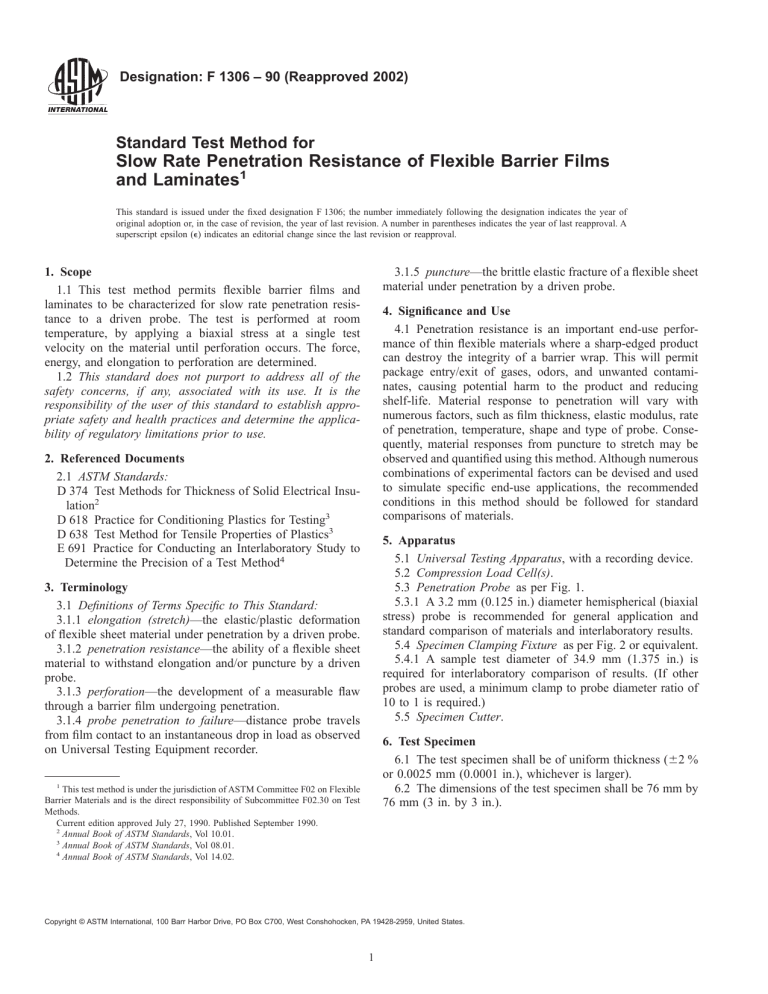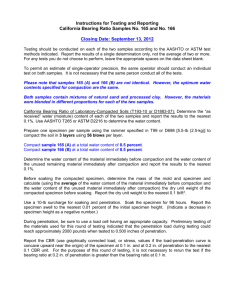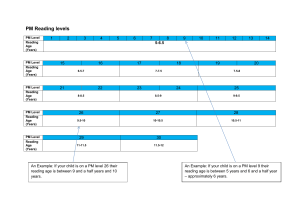
Designation: F 1306 – 90 (Reapproved 2002) Standard Test Method for Slow Rate Penetration Resistance of Flexible Barrier Films and Laminates1 This standard is issued under the fixed designation F 1306; the number immediately following the designation indicates the year of original adoption or, in the case of revision, the year of last revision. A number in parentheses indicates the year of last reapproval. A superscript epsilon (e) indicates an editorial change since the last revision or reapproval. 3.1.5 puncture—the brittle elastic fracture of a flexible sheet material under penetration by a driven probe. 1. Scope 1.1 This test method permits flexible barrier films and laminates to be characterized for slow rate penetration resistance to a driven probe. The test is performed at room temperature, by applying a biaxial stress at a single test velocity on the material until perforation occurs. The force, energy, and elongation to perforation are determined. 1.2 This standard does not purport to address all of the safety concerns, if any, associated with its use. It is the responsibility of the user of this standard to establish appropriate safety and health practices and determine the applicability of regulatory limitations prior to use. 4. Significance and Use 4.1 Penetration resistance is an important end-use performance of thin flexible materials where a sharp-edged product can destroy the integrity of a barrier wrap. This will permit package entry/exit of gases, odors, and unwanted contaminates, causing potential harm to the product and reducing shelf-life. Material response to penetration will vary with numerous factors, such as film thickness, elastic modulus, rate of penetration, temperature, shape and type of probe. Consequently, material responses from puncture to stretch may be observed and quantified using this method. Although numerous combinations of experimental factors can be devised and used to simulate specific end-use applications, the recommended conditions in this method should be followed for standard comparisons of materials. 2. Referenced Documents 2.1 ASTM Standards: D 374 Test Methods for Thickness of Solid Electrical Insulation2 D 618 Practice for Conditioning Plastics for Testing3 D 638 Test Method for Tensile Properties of Plastics3 E 691 Practice for Conducting an Interlaboratory Study to Determine the Precision of a Test Method4 5. Apparatus 5.1 Universal Testing Apparatus, with a recording device. 5.2 Compression Load Cell(s). 5.3 Penetration Probe as per Fig. 1. 5.3.1 A 3.2 mm (0.125 in.) diameter hemispherical (biaxial stress) probe is recommended for general application and standard comparison of materials and interlaboratory results. 5.4 Specimen Clamping Fixture as per Fig. 2 or equivalent. 5.4.1 A sample test diameter of 34.9 mm (1.375 in.) is required for interlaboratory comparison of results. (If other probes are used, a minimum clamp to probe diameter ratio of 10 to 1 is required.) 5.5 Specimen Cutter. 3. Terminology 3.1 Definitions of Terms Specific to This Standard: 3.1.1 elongation (stretch)—the elastic/plastic deformation of flexible sheet material under penetration by a driven probe. 3.1.2 penetration resistance—the ability of a flexible sheet material to withstand elongation and/or puncture by a driven probe. 3.1.3 perforation—the development of a measurable flaw through a barrier film undergoing penetration. 3.1.4 probe penetration to failure—distance probe travels from film contact to an instantaneous drop in load as observed on Universal Testing Equipment recorder. 6. Test Specimen 6.1 The test specimen shall be of uniform thickness (62 % or 0.0025 mm (0.0001 in.), whichever is larger). 6.2 The dimensions of the test specimen shall be 76 mm by 76 mm (3 in. by 3 in.). 1 This test method is under the jurisdiction of ASTM Committee F02 on Flexible Barrier Materials and is the direct responsibility of Subcommittee F02.30 on Test Methods. Current edition approved July 27, 1990. Published September 1990. 2 Annual Book of ASTM Standards, Vol 10.01. 3 Annual Book of ASTM Standards, Vol 08.01. 4 Annual Book of ASTM Standards, Vol 14.02. Copyright © ASTM International, 100 Barr Harbor Drive, PO Box C700, West Conshohocken, PA 19428-2959, United States. 1 F 1306 – 90 (2002) 10. Procedure 10.1 Following the instrument manufacturer’s instructions, calibrate the test equipment. 10.2 Select an equipment load range so that specimen puncture occurs within 20 to 80 % of the same. 10.3 Using the specimen cutter, cut each sample material into a minimum of five 3 in. by 3 in. pieces. 10.4 Measure the caliper (average of 3 readings) in the center of a film specimen. 10.5 Adjust the universal tester cross head speed to 25 mm/min (1.0 in./min). (Set chart speed recorder to 500 mm/min (20 in./min), if applicable.) Select a data acquisition rate to give a minimum resolution of 0.1 mm/point of penetration. 10.6 Clamp the film specimen in the holder, place sample holder directly under crosshead probe, center and lower it as close as possible to the film specimen without making contact. 10.7 Set the appropriate stops and returns on the tester. Reset data collection devices to zero, if applicable. 10.8 Activate universal tester. At the first sign of a perforation through the film, return the crosshead to origination point. (A perforation is any size hole in the film specimen visible to the naked eye, or a point where an instantaneous drop in load to near zero occurs.) See Fig. 3. FIG. 1 Penetration Probe NOTE 1—In case of laminate materials, multiple drops in load may be observed as discrete layers fail. Under this condition the last instantaneous drop to near zero would be considered a failure. 10.9 Record specimen identification, force (peak) to break, energy (work) to break, and probe penetration (at first break) from mechanical testing software output (Fig. 3). (If using chart recording instruments, record specimen identification on chart and integrator reading if used.) 10.10 Repeat test sequence (10.1 to 10.9) for the remaining samples. 11. Calculation 11.1 Compute the values of peak force, probe penetration to break, and energy to break. 11.1.1 Software computed values are acceptable. 11.2 Use the following formulas for calculating the required values for data acquisition with a time based chart recorder. 11.2.1 Force to Break—Peak force to achieve break (Newtons): FIG. 2 Specimen Clamping Fixture 7. Preparation of Apparatus 7.1 Consult the equipment operations manual for instructions to set up and operate the equipment. 7.2 Install probe apparatus. 7.3 Center probe over the fixture. 8. Number of Test Specimens 8.1 Test at least five specimens for each sample. 9. Conditioning 9.1 Condition the test specimens at 23 6 2°C (73.4 6 3.6°F) and 50 6 5 % relative humidity for not less than 40 h prior to test in accordance with Procedure A of Practice D 618 for those tests where conditioning is required. 9.2 Conduct tests in the standard laboratory atmosphere of 23 6 2°C (73.4 6 3.6°F) and 50 % 6 5 % relative humidity unless otherwise specified in this test method. FIG. 3 Graphical Output of Slow Rate Penetration Test 2 F 1306 – 90 (2002) D N 5 R 3 L or W 3 L 13.1.1 Table 1 and Table 2 are based on a round robin conducted in 1988–89 in accordance with Practice E 691, involving six materials tested by six laboratories. For each material, all the samples were prepared at one source, but the individual specimens were prepared at the laboratories which tested them. Each test result was the test value of an individual determination. Each laboratory obtained five test results for each material. Each laboratory tested each material two ways, each of which is treated as a separate material. 13.1.1.1 Table 3 and Table 4 are based on the same round robin discussed above, but the data is based on three and four laboratories respectively and should be used with caution due to the small amount of data. (1) where: N = force to break (Newtons), R = chart reading (%), expressed as a decimal, L = full scale load (FSL), N D = recorded actual millimeters of chart in vertical axis, from start of test to finish, W = full scale width of chart, mm. 11.2.2 Probe Penetration—Depth probe traveled in penetrating film specimen (mm), from initial probe contact with sample, to penetration at break: P5 D3S C (2) NOTE 2—The following explanations of r and R (13.1.2 through 13.1.2.3) are only intended to present a meaningful way of considering the approximate precision of this test method. The data in Table 1 and Table 3 should not be rigorously applied to acceptance or rejection of material, as those data are specific to the round robin and may not be representative of other lots, conditions, materials, or laboratories. Users of this test method should apply the principles outlined in Practice E 691 to generate data specific to their laboratory and materials, or between specific laboratories. The principles of 13.1.2 thru 13.1.2.3 would then be valid for such data. where: P = probe travel to penetration at first break, mm, D = recorded actual millimeters of chart in vertical axis, from start of test to finish, S = crosshead speed, (mm/min), and C = chart speed, (mm/min). 11.2.3 Energy—Work to break (Joules): S J5I3L3Z (3) 13.1.2 Concept of r and R—If Sr and SR have been calculated from a large enough body of data, and for test results that were test values from testing individual specimens: 13.1.2.1 Repeatability Limit, r—(Comparing two test results for the same material, obtained by the same operator using the same equipment on the same day.) The two test results should be judged not equivalent if they differ by more than the r value for that material. 13.1.2.2 Reproducibility Limit, R—(Comparing two test results for the same material, obtained by different operators using different equipment in different laboratories.) The two test results should be judged not equivalent if they differ by more than the R value for that material. 13.1.2.3 Any judgment in accordance with 13.2.1 or 13.2.2 would have an approximate 95 % (0.95) probability of being correct. 13.2 Bias:—There are no recognized standards by which to estimate the bias of this test method. where: J = energy, J, L = full scale load (FSL), N, S = crosshead speed, (mm/min), I = integrator reading, (counts), and Z = integrator, (counts/min). 12. Report 12.1 Report the following information: 12.1.1 Sample identification. 12.1.2 Mean and standard deviation of five values for: 12.1.2.1 Force at break (N), 12.1.2.2 Energy to break (J), 12.1.2.3 Probe penetration (mm), and 12.1.2.4 Caliper (mm) of film specimens for each sample (three values). 13. Precision and Bias 13.1 Precision: TABLE 1 Puncture Force (6 Laboratories) Material BW 010 BW 010 BW 82 BW 82 BW 117 BW 117 BW 295 BW 295 BW 341 BW 341 BW 234 BW 234 Material Orientation Inside Outside Inside Outside Inside Outside Inside Outside Inside Outside Inside Outside Values expressed in units of Newtons Average Sr SR r R 6.63 6.72 9.47 9.08 12.10 12.37 42.54 36.49 41.83 42.94 72.31 65.64 0.187 0.360 1.94 2.23 1.615 1.798 1.776 0.983 2.697 3.400 11.080 16.421 0.676 0.903 2.034 2.416 2.238 2.852 2.078 3.066 3.502 4.971 14.285 17.266 0.525 1.015 5.429 6.226 4.521 5.029 4.966 2.756 7.547 9.514 31.061 45.969 1.891 2.528 5.696 6.773 6.608 7.983 5.816 8.580 9.803 13.920 39.961 48.372 3 F 1306 – 90 (2002) TABLE 2 Puncture Penetration (6 Laboratories) Values expressed in mm Material BW BW BW BW BW BW BW BW BW BW BW BW 010 010 82 82 117 117 295 295 341 341 234 234 Material Orientation Inside Outside Inside Outside Inside Outside Inside Outside Inside Outside Inside Outside Average Sr SR r R 0.0107 0.0111 0.0060 0.0058 0.0097 0.0010 0.0071 0.0071 0.0062 0.0065 0.0061 0.0058 0.0095 0.0006 0.0011 0.0018 0.0013 0.0012 0.0004 0.0002 0.0003 0.0042 0.0004 0.0012 0.0031 0.0031 0.0023 0.0024 0.0028 0.0029 0.0019 0.0010 0.0018 0.0019 0.0018 0.0018 0.0027 0.0017 0.0031 0.0050 0.0035 0.0032 0.0061 0.0007 0.0008 0.0012 0.0012 0.0033 0.0088 0.0086 0.0063 0.0068 0.0080 0.0081 0.0052 0.0028 0.0050 0.0052 0.0051 0.0050 TABLE 3 Material Thickness (3 Laboratories) Values expressed in mm Material BW BW BW BW BW BW BW BW BW BW BW BW 010 010 82 82 117 117 295 295 341 341 234 234 Material Orientation Inside Outside Inside Outside Inside Outside Inside Outside Inside Outside Inside Outside Average Sr SR r R 0.050 0.049 0.020 0.020 0.013 0.012 0.113 0.113 0.031 0.031 0.210 0.211 0.0011 0.0019 0.0006 0.0009 0.0009 0.0012 0.0024 0.0018 0.0015 0.0019 0.0168 0.0160 0.0012 0.0026 0.0008 0.0015 0.0010 0.0012 0.0029 0.0024 0.0015 0.0024 0.0168 0.0207 0.0030 0.0052 0.0018 0.0025 0.0025 0.0032 0.0069 0.0050 0.0042 0.0053 0.0470 0.0047 0.0034 0.0074 0.0023 0.0043 0.0028 0.0034 0.0080 0.0034 0.0042 0.0068 0.0470 0.0579 4 F 1306 – 90 (2002) TABLE 4 Puncture Energy (4 Laboratories) Values expressed in Joules Material BW BW BW BW BW BW BW BW BW BW BW BW 010 010 82 82 117 117 295 295 341 341 234 234 Material Orientation Inside Outside Inside Outside Inside Outside Inside Outside Inside Outside Inside Outside Average Sr SR r R 0.0490 0.0502 0.0270 0.0268 0.0599 0.0597 0.1374 0.0926 0.1077 0.1177 0.1839 0.1459 0.0042 0.0039 0.0104 0.0091 0.0143 0.0176 0.0111 0.0172 0.0113 0.0125 0.0384 0.0465 0.0104 0.0071 0.0115 0.0123 0.0166 0.0242 0.0111 0.0258 0.0178 0.0232 0.0503 0.0586 0.0118 0.0109 0.0290 0.0254 0.0379 0.0494 0.0311 0.0481 0.0317 0.0348 0.1074 0.1302 0.0292 0.0197 0.0323 0.0343 0.0464 0.0679 0.0311 0.0722 0.0500 0.0649 0.1158 0.1642 ASTM International takes no position respecting the validity of any patent rights asserted in connection with any item mentioned in this standard. Users of this standard are expressly advised that determination of the validity of any such patent rights, and the risk of infringement of such rights, are entirely their own responsibility. This standard is subject to revision at any time by the responsible technical committee and must be reviewed every five years and if not revised, either reapproved or withdrawn. Your comments are invited either for revision of this standard or for additional standards and should be addressed to ASTM International Headquarters. Your comments will receive careful consideration at a meeting of the responsible technical committee, which you may attend. If you feel that your comments have not received a fair hearing you should make your views known to the ASTM Committee on Standards, at the address shown below. This standard is copyrighted by ASTM International, 100 Barr Harbor Drive, PO Box C700, West Conshohocken, PA 19428-2959, United States. Individual reprints (single or multiple copies) of this standard may be obtained by contacting ASTM at the above address or at 610-832-9585 (phone), 610-832-9555 (fax), or service@astm.org (e-mail); or through the ASTM website (www.astm.org). 5



